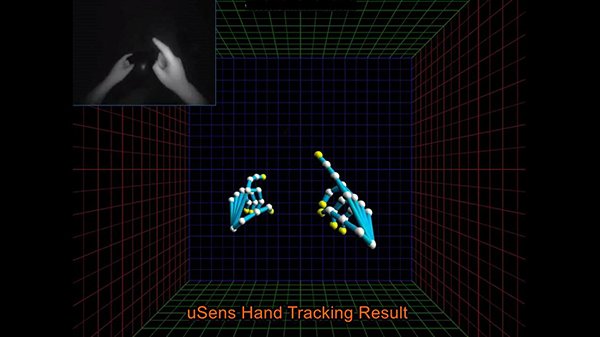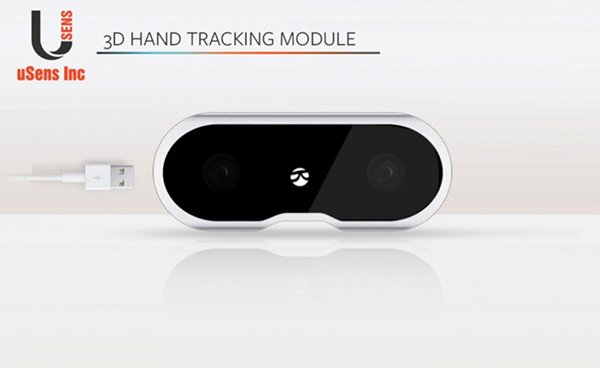Consumers around the world are enjoying the novelty experience brought about by VR. Among them, consumers who are in the late stage of lazy cancer are also expecting the black technology of the VR community because of their "free hands."

uSens gesture recognition technology
Interaction has always been a problem that people in the VR industry are trying to overcome. How to move the most natural "hands-free interaction" in the real world into the virtual world has also caused Microsoft and other giants to "fail". A startup company from Silicon Valley has also received extensive attention at home and abroad due to its gesture recognition technology. Xiao Bian today came to discover the name of uSens, the VR interactive industry company.
Core Technology: Tracking! 26 degrees of freedom gesture tracking and 6 degrees of freedom head position tracking
The basic principle of uSens Ling gesture recognition technology is multi-angle imaging, that is, the position of the object to be captured is acquired simultaneously by different cameras, so that the depth of the object from the camera is calculated by an algorithm, which is similar to the principle of human eyes.
uSens uses a binocular infrared camera to directly process images through an exclusive algorithm. It does not require additional computing units to obtain depth information through calculations, resulting in lower cost and power consumption, higher accuracy in close proximity, and better suitability. For mobile VR platform.
The uSens Ling gesture recognition technology is the "flag" of "26 degrees of freedom." Why is the number 26? uSens's engineers have also given science to the Xiaobian. “The degree of freedom is the magnitude of movement in one dimension. For one hand, one knuckle corresponds to one to three degrees of freedom. Degrees, one hand has 26 degrees of freedom.†uSens Ling gesture recognition technology captures the full range of 26 degrees of freedom by capturing the 22 joints of the hand, recognizing single hands and various hand postures, including clicks. , Sliding, Grasping, Touching, Flip, Fist, Clapping, Praising, Ok, etc.
In addition to conquering the 26-DOF gesture recognition, uSens's 6-DOF head position tracking technology also enables tracking of all head positions in a moving VR. Previously, uSens Ling Sen's "26-DOF" position tracking and AR superposition function's "Impression" head-referenced design has attracted attention, and uSens has also called "Summoning Dragons" on Kickstarter. "The stance of winning the throne of VR dark horse.

uSens Fingo Module
"Spearhead" points to mobile VR Fingo ready to go
The VR experience on the PC side is even better than that on the mobile side. At present, many interactive researches focus on the PC experience. Leap Motion, which also focuses on gesture recognition, is targeting the PC side. USens, who did not take the unusual route, pointed out that the spearhead pointed at mobile terminals that required higher algorithm speeds and had many limitations in power consumption.
“Mobile VR is the mainstream VR device that can truly be accepted by mass consumers, and the non-natural 3D human-computer interaction experience will be the most important factor hindering mobile VR from entering the mass market. uSens is focused on solving the interactive problem of mobile terminals. Making the future VR headsets easier and more portable will also play a role in promoting the popularity of VR." The uSens Lingo CTO fee is also quite a "big fan of love" when explaining its "mobile road" choice.
Fingo is the "gift" sent by uSens to the VR industry. With "tracking technology" as the core, it has the functions of gesture and position recognition. The hardware display, content developers and channel partners can all be configured according to their needs.
In addition to allowing the Fingerbo module to be externally gestured on mobile heads such as the Gear VR, uSens will also provide pure technology output to large companies with technical integration capabilities, as well as provide "intimate services" that interact with gestures. The location tracking module is placed in the vendor's hardware product. Thoughtful uSens Ling seems to be determined to blow up a "hand-controlled wind" in the VR world.
Although many foreign companies have also explored in the area of ​​VR "hands-free interaction", they are far from being able to reach Chinese consumers. Although he was born in Silicon Valley, uSens was founded by the Chinese. Now he builds offices in Beijing, Shenzhen, and Hangzhou. It is reported that the first press conference of uSens China will be held in Beijing on August 24th. Fingo SDK and different hardware modules will be officially released. Domestic VR practitioners can get Fingo related suites for content development in various fields. Hardware adaptation. It can be foreseen that, guided by uSens' Lingxin innovation technology, the mobile VR "Interactive 2.0 era" is coming soon.